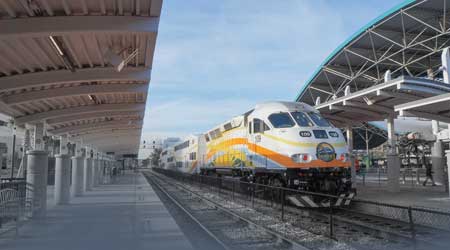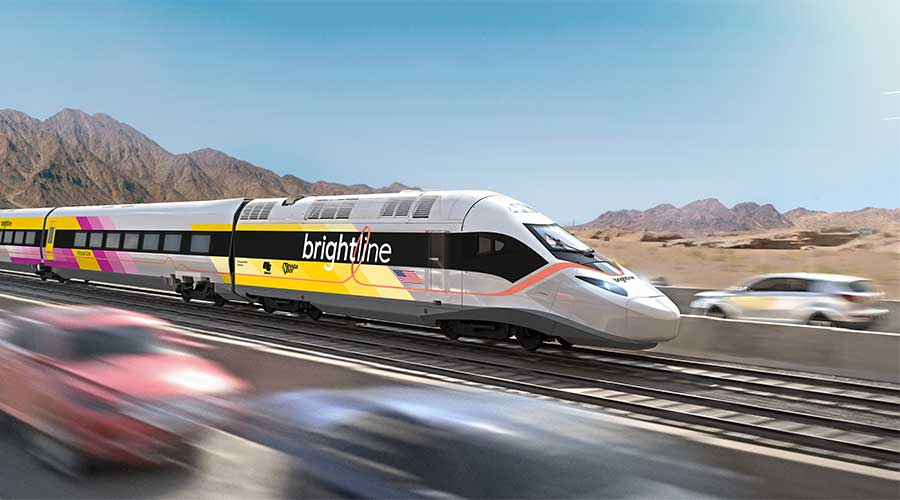Stay updated on news, articles and information for the rail industry
 railPrime
railPrime
October 2018
Part 1 : Progressive Railroading's Passenger Rail at a Glance 2018: Preface
Part 2 : Progressive Railroading's Passenger Rail at a Glance 2018: Amtrak, California, & Colorado
Part 4 : Progressive Railroading's Passenger Rail at a Glance 2018: New Jersey, New York, Ohio & Oregon
Rail News: AmtrakProgressive Railroading's Passenger Rail at a Glance 2018: Amtrak, California, & Colorado

Amtrak*
Amtrak is the U.S. intercity passenger railroad. It is a federally chartered corporation, with the federal government as majority stockholder. The board is appointed by the president of the United States and confirmed by the U.S. Senate. Amtrak is operated as a for-profit company rather than a public authority.
Service launched: 1971
Route Miles: 21,400
Rolling stock: As of January 2018, active Amtrak-owned or leased passenger equipment includes 20 Acela Express high-speed trainsets; 1,242 passenger cars including Amfleet, Superliner, Viewliner, Horizon and other types; 80 baggage cars; 80 Auto Train vehicle carriers; 259 road diesel locomotives and 68 ACS-64 electric locomotives. Amtrak Cascades service primarily operates with six Talgo trainsets with cars owned by Amtrak and the states of Oregon and Washington. In FY 2017, Amtrak began receiving new single-level dining cars that are part of a larger 130-car order that also includes sleeping (pending) and baggage (delivered) cars.
Annual ridership: 31.7 million passenger trips (FY2017)
Total revenue: $3.3 billion (FY2017)
Operating earnings: $194 million (FY2017)
Capital and operating expense: $5.9 billion (FY2017)
Major capital improvement projects underway or scheduled to begin in one year:
Amtrak announced in August 2016 that it contracted with Alstom to produce 28 next-generation high-speed trainsets that will replace the equipment used to provide Acela Express service. The first trainset should enter revenue service in 2021, and all trainsets are expected to be in service by the end of 2022. In addition to the trainsets, Amtrak is investing in infrastructure needed to improve the onboard and station customer experience and accommodate increased high-speed rail service levels. Amtrak will invest in significant improvements at Washington Union Station; and Moynihan Station New York, as well as track capacity and ride quality improvements to the Northeast Corridor that will benefit all intercity and commuter customers. Amtrak will also modify fleet maintenance facilities to accommodate the new trainsets.
* Information source: Amtrak Company Profile FY2017
CALIFORNIA
Bay Area Rapid Transit
For more than 40 years, Bay Area Rapid Transit (BART) has provided reliable rapid transit service in the San Francisco Bay Area. Over that time, the system has grown to accommodate the needs of a more densely populated and expanding region. The system carries an average of 415,000 on a typical weekday.
Service launched: 1972
Route Miles: 121
Rolling stock: 669 rail cars, average age 30 years
Cars/locomotives on order: BART has ordered 775 rail cars manufactured by Bombardier, with expected delivery now through 2022.
Annual ridership: 120,554,337 (FY2018)
Operating costs: $920.6 million (FY2018)
Capital costs: $1.4 billion (FY2018)
Stations: 48
Major capital improvement projects underway:
Rebuilding efforts are underway across the system at BART because of voter-approved Measure RR. The bond measure was approved by district voters in 2016 and provides BART with $3.5 billion for critical infrastructure projects. Already, BART has completed a major section of track repair and upgrades in downtown Oakland, issued $300 million in certified climate-friendly green bonds and awarded six general engineering service contracts totaling $150 million. A Bond Oversight Committee has been formed to verify that BART spends the bond revenues as promised.
Caltrain*
Caltrain is a commuter railroad operating between San Francisco and San Jose, with limited service to Gilroy. Caltrain is owned and operated by the Peninsula Corridor Joint Powers Board, which is made up of representatives from the city and county of San Francisco, the San Mateo County Transit District and the Santa Clara Valley Transportation Authority. The transit district is the managing agency, providing administrative services and overseeing the operating contract.
Service launched: The San Francisco and San Jose Railroad Co. began passenger-rail service on the Peninsula in 1863. The system now known as Caltrain had its start in 1992, when the Peninsula Corridor Joint Powers Board took over the railroad’s operation.
Miles: 51
Rolling stock: 29 locomotives, 134 rail cars, 52 bike cars
Annual ridership: 18,567,173
Operating budget: $146.4 million (2017)
Capital budget: $250.9 million (2017)
Stations: 31
Major capital improvement projects underway:
Communications-based overlay signal system/positive train control. Scheduled for completion: 2018. Cost: $231 million. The most crucial factor constraining Caltrain’s ability to offer more service is its wayside signal system. This advanced signal system will allow Caltrain to operate more service. PTC, which will help eliminate train-to-train collisions, is a federal mandate.
Caltrain’s Modernization Program (CalMod) aims to provide more service to more riders, cut air pollution, increase operating performance and take more cars off the region’s congested roads. Modernization includes an advanced signal system, the electrification of the corridor between San Francisco and San Jose and the replacement of Caltrain’s existing diesel trains with more efficient electric trains. With the addition of other infrastructure improvements, CalMod will support California’s high-speed rail service. Funding agreements and station legislation have been approved that integrate high-speed rail and Caltrain on a shared, “blended” system that is primarily two tracks. Caltrain is working with neighboring communities and the California High-Speed Rail Authority to identify and study the improvements necessary to support high-speed train service after the CalMod program’s completion, which is slated for 2021.
* Information source: caltrain.com
L.A. County Metropolitan Transportation Authority
The Los Angeles County Metropolitan Transportation Authority (Metro) is the public transportation agency for Los Angeles County. It was formed in 1993 out of a merger of the Southern California Rapid Transit District and the Los Angeles County Transportation Commission. It is chartered under state law as a regional transportation planning agency. Metro directly operates bus, light rail, heavy rail and bus rapid-transit services. It provides funding and directs planning for commuter-rail and freeway/expressway projects in the county.
Service launched: light rail, 1990; heavy rail, 1993
Miles: light rail, 83.6; heavy rail, 14
Rolling stock: 104 rail cars, average age 22 years; 298 light-rail vehicles, average year 12.4 years
Cars/locomotives on order: 235 high-floor light-rail vehicles manufactured by Kinkisharyo International LLC, with expected delivery to be completed by August 2020.
Annual ridership: 66,387,207 light rail; 43,752,286, heavy rail
Annual operating cost: $405,239,390, light rail; $136,723,383, heavy rail
Annual capital cost: $274,531,000, which includes total for light- and heavy-rail systems, facilities, wayside and vehicle replacements
Stations: 79
Major capital improvement projects underway: N.A.
Metrolink*
Metrolink is Southern California’s regional commuter-rail service in its 25th year of operation. Metrolink is governed by the Southern California Regional Rail Authority (SCRRA), a joint powers authority made up of an 11-member board representing the transportation commissions of Los Angeles, Orange, Riverside, San Bernardino and Ventura counties. Metrolink operates over seven routes through a six-county network.
Service launched: 1992
Route Miles: 540 including shared miles; 388 excluding shared miles
Rolling stock: 56 locomotives, 73 cab cars, 185 coaches
Cars/locomotives on order: 38 locomotives
Ridership: 39,131 average weekday; 10,004 average Saturday; 8,128 average Sunday
Operating budget: $243 million. Projected percent of operating costs covered by operating revenue: 41.4 percent; projected percent of operating costs covered by fares: 35.1 percent.
Capital program budget: $395.2 million
Stations: 61
Major capital improvement projects underway: N.A.
* Information source: SCRRA’s Q2 2017-18 Fact Sheet
San Francisco Municipal Transportation Agency*
The San Francisco Municipal Transportation Agency (SFMTA) has oversight of the Municipal Railway (Muni) public transit.
Service launched: light rail, 1860
Route Miles: light rail, 71.5
Rolling stock: 151 light-rail vehicles
Ridership: 173,500 average weekday (light rail)
Baseline budget: $1.09 billion (FY2018)
Capital improvement cost: $3.4 billion (according to FY2017-2021 capital improvement program)
Stations: 9 Muni subway stations, 24 Muni surface stations
Major capital improvement projects underway: The Central Subway project is designed to improve public transportation in San Francisco by extending the Muni Metro T Third Line through SoMa, Union Square and Chinatown. It will provide a direct link between downtown and the existing T Third Line route on 3rd Street. When Central Subway is completed, T Third Line trains will travel mostly underground from the 4th Street Caltrain Station to Chinatown, bypassing heavy traffic on congested 4th Street and Stockton Street. Four new stations will be built along the 1.7-mile alignment. The project is slated for revenue service in 2019.
* Information source: sfmta.com
COLORADO
Regional Transportation District
The Regional Transportation District of Denver (RTD) develops, operates and maintains a public transportation system that meets the transit needs of close to 3 million people with an eight-county service area in the Denver region. The agency’s buses, rail lines, shuttles and additional services provide about 100 million annual passenger trips.
Service launched: light rail, 1994; commuter rail, 2016
Route Miles: light rail, 58.5; commuter rail, 29 (35 when the G Line opens)
Rolling stock: 66 commuter-rail cars (average age 4 years); 172 light-rail vehicles (average 12 years)
Cars/locomotives on order: 29 Siemens SD160 light-rail vehicles with expected delivery in 2018-19
Annual ridership: light rail, 24,645,459; commuter rail, 6,950,256
Operating costs: light rail, $115,181,118; commuter rail, $39,236,112 (2017)
Capital costs: light rail, $171,813,153; commuter rail, $197,517,183 (2017)
Stations: light rail, 54; commuter rail, 9; commuter rail after the G Line opens, 17
Major capital improvement projects underway:
• North Metro Corridor: a $817 million project that includes 12.5 miles of single commuter-rail track; 6 new stations, tying into Denver Union Station; 1 parking structure at 104th, with 900 parking spaces; 4 public grade crossings; 11 bridges; Skyway Bridge, a 2-mile structure making it the longest bridge in Colorado. Contracting team: Regional Rail Partners, a joint venture of Balfour Beatty/Graham Contractors; design-build contract NTP Dec. 13, 2013; integrated testing to begin first-quarter 2019.
• Southeast Rail Corridor: A $238 million project that includes 2.5 mile double track light-rail extension; 3 new stations; 1 parking structure at the end-of-line station with 1,300 spaces; 3 bridge structures; and 1 grade crossing. Project groundbreaking was in May 2016; contract completion date is March 31, 2019; revenue service is anticipated in second-quarter 2019; Balfour Beatty Infrastructure is the prime contractor; project is on schedule with integrated testing slated to begin in fourth-quarter 2018. The federal government is providing $92 million in funding toward the project.
Keywords
Browse articles on Amtrak California Colorado passenger rail Bay Area Rapid Transit BART Caltrain Los Angeles County Metropolitan Transportation Authority Metro Metrolink San Francisco Municipal Transportation Agency SFMTA Regional Transportation District of Denver RTDContact Progressive Railroading editorial staff.


 LRW Honors Amtrak’s Acheson As Railway Woman Of The Year
LRW Honors Amtrak’s Acheson As Railway Woman Of The Year
 From Editor-In-Chief Foran: Of Gender Equity And Inclusion
From Editor-In-Chief Foran: Of Gender Equity And Inclusion
 Spotlight On Some Of Today’s Rail Safety Products
Spotlight On Some Of Today’s Rail Safety Products
 Women of Influence in Rail eBook
Women of Influence in Rail eBook








